MAGIC
Skip navigation and go to main content
- Home
- General Information
- Science with MAGIC
- MAGIC members
- Maintenance
MAGIC Highlights
MAGIC Telescopes scrutinize the center of our home Galaxy for fingerprints of dark matter
An international team of scientists from the MAGIC collaboration, using a system of two 17m diameter telescopes on the Canary Island of La Palma, have observed the center of the Milky Way for 233 hours in search for very high energy gamma-ray lines that could originate from particle dark matter. Those observations did not turn up a sign of the elusive dark matter, but help constrain possible properties of candidate particles. The scientists report on their result in the issue N. 6, Feb 2023, of the prestigious journal Physical Review Letters.
Although there is clear evidence from a wealth of astronomical observations – including the rotation curves of galaxies, gravitational lensing, and the formation of structure throughout the Universe – that the majority of all matter in the Cosmos is of a very different type than the matter we encounter in our everyday lives, the exact nature of that “dark matter” has so far eluded all attempts to be traced. Physicists presume that the dark matter may consist of not yet discovered particles from beyond the Standard Model of physics, and may thus be important pointers towards a deeper understanding of Nature as a whole, if identified. The hunt for those particles has been on for decades, and scientists all over the world employ powerful particle accelerators, sensitive experiments in deep underground caverns, and huge telescopes to finally bring light to that dark corner of reality. Those efforts, however, are very challenging precisely due to the elusive nature of the candidate particles: they are presumably much heavier than the particles we find in the nuclei of the atoms that are the basic building blocks of ordinary matter, and interact at most via gravity and perhaps through the so-called weak force. What they however lack is the basic property due to which we normally identify and study ordinary matter: the direct ability to absorb or emit light. Due to that, any possible signature of the dark matter is hard to trace, and hard to discriminate against backgrounds e.g. due to stellar explosions and other more or less ordinary processes in the Universe. But there may still be a chance, as some dark matter particles might interact with each other, and eventually produce unique signatures like the emission of very energetic light.
For the study reported here, scientists employed the highly sensitive MAGIC telescope system located at the Roque de Los Muchachos observatory on the Canary Island of La Palma (Spain, Europe). This instrument consists of two telescopes, each having a primary mirror with a diameter of 17m and a highly sensitive photodetection camera. The telescopes capture brief flashes – the Cherenkov light – that are produced when light of energies billions to trillion times larger than the energy of the visible light (teraelectronvolt, or TeV-energies) hits the atmosphere of the Earth. This way, MAGIC can provide ground-based observations at those high energies, although such highly energetic photons do not penetrate our atmosphere. The very high sensitivity of the MAGIC system at TeV-energies is crucial, as the mass of the dark matter particles – and thus the light that may be produced in their rare interactions – may well be around those energies. In order to be able to distinguish any possible signal from dark matter interactions from already known astrophysical phenomena, the MAGIC scientists specifically searched for gamma-ray “lines” – light emitted within a very narrow and specific range of energies. Quite similar to the lines in the fingerprints of a human, which can identify any single human in a crime scene investigation, such TeV-lines would be a giveaway for interactions of particles much heavier than anything known within the Standard Model, and can thus be considered a “smoking gun signature” for dark matter. The team decided to point the MAGIC telescopes at the center of our home galaxy, the Milky Way, because this region is strongly suspected to harbor a large concentration of dark matter. Scrutinizing a total of 223 hours of observational data collected over a timespan of seven years, from 2013 to 2020, the scientists did not find any line-like emission.
Tomohiro Inada, a postdoctoral researcher affiliated to ICRR and University of Tokyo, Japan and leading author of this effort, says: “We observed around the Galactic Center of the Milky Way, which is one of the most fascinating sources in the field of astrophysics, to search for tiny signals from dark matter. Sadly, no signals were found but our results tested one of the well-motivated new particle models beyond the standard model, so-called supersymmetric (SUSY) particles, and we showed the potential of our telescope for such a fundamental physics case”.
Daniel Kerszberg, Ramon y Cajal fellow at IFAE, Barcelona, Spain, and corresponding author of this work, adds: “The center of the Milky Way is a region crowded with astrophysical sources which also emit high-energy TeV photons, therefore we had to be very careful with the statistical tools we used to search for a possible dark matter signal and obtain our results”. This result now will help theoretical physicists to further constrain possible properties of dark matter particles and the physics models from which they may originate. Says Moritz Huetten, postdoctoral researcher at ICRR and the University of Tokyo, Japan and one of the corresponding authors: “The upper limits on the maximum possible interaction strength between dark matter particles strongly depend on the density of dark matter particles we expect at the center of our Galaxy. Therefore, we tested our data for various assumptions of the distribution of dark matter in the inner Milky Way.”
In the future, the applied technique will enable even more sensitive searches with MAGIC and the new generation of very high energy gamma-ray experiments, like the Large Size Telescopes (LST) from the Cherenkov Telescope Array (CTA), that are currently being constructed next to the MAGIC telescopes. As in any criminal investigation, narrowing down the list of suspects is often the first step towards solving the mystery!
References:
David Paneque (Spokesperson of the MAGIC Collaboration)
Max Planck Institute for Physics
Föhringer Ring 6
D-80805 Munich (Germany)
dpaneque@mpp.mpg.de
Marina Manganaro (Outreach & DEI Coordinator of the MAGIC Collaboration)
Unviersity of Rijeka, Faculty of Physics
Radmile Matejčić 2
51000 Rijeka (Croatia)
marina.manganaro@uniri.hr
MAGIC Telescope System detects energetic nuclear blast from vampire star
Scientists from the MAGIC collaboration, using a system of two 17m diameter imaging air Cherenkov telescopes located on the Canary Island of La Palma, Spain, have detected very high energy gamma-rays from a recurrent nova in the Milky Way. This event is the first one that has been detected at such energies and is providing new insight into this class of eruptions, highlighting the potential role they play for producing the highly energetic cosmic rays that permeate the Milky Way.
The researchers present the results of their observations and insights they gained into this type of stellar explosions in an article in the journal Nature Astronomy on 14.04.2022.
The life cycles of stars can be long and complex, from their birth inside dense clouds of cosmic gas until their often fiery end. How such a stellar death plays out depends on the mass of the star: for our own Sun, scientists expect that the nuclear fusion of hydrogen to helium in its core will end within the next 5 billion years. The Sun will then greatly expand to become a so-called red giant star, before collapsing back to a dense stellar corpse, a white dwarf. Such an end is typical for stars with masses roughly similar to the Sun. The material that makes up a white dwarf is very dense: a teaspoon full of it would weigh about a metric ton. Under some circumstances these dense stellar corpses can produce titanic explosions from beyond the grave. If the white dwarf has a stellar companion which itself progresses to the red giant phase, hydrogen from the extended outer layers of the giant can succumb to the fatal gravitational attraction of the dense dwarf, and accumulate on its surface. In some such systems, the pressure and temperature inside the accumulated layers reach a point where nuclear fusion reactions begin. Such a situation, a transfer of fresh material from a star still in the active stage of its life to a stellar corpse, can easily be reminiscent of legends about vampires sucking the life juice out of their victims, in this instance it is really a case of vampirism gone bad: The resulting nuclear explosion on the surface of the white dwarf ejects much of the hydrogen and fusion products into space. The explosion is very luminous, in many cases a factor of 100 000 brighter than the luminosity of a normal star like our Sun. Such a rapid increase in brightness of an otherwise unremarkable stellar system often led the astronomers of old to believe a new star had appeared – thus the term “stella nova” (new star, and in short “nova”) became a synonym for this process.
“While the material ejected from the surface of the white dwarf escapes at a tremendous speed of two to four thousand kilometers per second, for the uneven stellar companions the cycle of gas transfer from dilute giant to dense dwarf can begin anew, and a future recurrence of the nova eruption will happen in some systems,” explains Francesco Leone (INAF Rome). Those then are called recurrent novae. For one well known recurrent nova in our Milky Way, the object RS Ophiuchi in the constellation Ophiuchus (the serpent-bearer) the typical time between two eruptions is about 15 years. With the last blast from the system having been seen in the year 2006, astronomers at the beginning of the third decade of the third millennium already knew that this celestial hydrogen bomb was primed and ready. They kept a watchful eye on the object at a distance of about 8000 light years from Earth.
Vandad Fallah Ramazani (FINCA and RU Bochum) recalls the events that followed: “On August 8, 2021, light of the explosion reached the Earth and was promptly detected by optical telescopes, by the Large Area Telescope on the orbiting gamma-ray observatory Fermi, operated by NASA, and also by the H.E.S.S. telescope system in Namibia. On August 9, triggered by the Fermi and optical detections, the MAGIC collaboration trained the twin 17m imaging air Cherenkov telescopes the collaboration operates on the Canary Island of La Palma at the ongoing eruption.”
A suite of other observations took place contemporaneously, including ground-based optical telescopes like the Joan Oró Telescope (TJO) at Montsec observatory, the Echelle spectrograph of the Varese 0.84 m telescope, and the CAOS spectropolarimeter at Serra La Nave, making this the first nova being detected over such a wide energy range from both ground and space.
Says Ruben Lopez Coto (INFN Padova), one of the corresponding authors: “The eruption of RS Ophiuchi is a rare event in the gamma-ray sky: it is the most luminous nova and the one with the highest flux detected in gamma rays so far, and we just caught it on time.”
Owing to the good observation conditions on La Palma, the fast reaction of the collaboration, and the unique sensitivity of the MAGIC system, the nova could be clearly detected at energies hundred billion times more energetic than visible light.
Alicia López Oramas (IAC Tenerife), corresponding author of the study, describes the new window to the sky that was thus opened: “This research has identified novae as a new type of source of very high energy gamma rays. This discovery has thus opened a new line of research in very high energy astronomy.”
Together with data from other wavelength regimes, the researchers were able to unravel a fascinating scientific story by using the gamma-ray observations of MAGIC and Fermi-LAT in concert. The nova explosion was energetic enough to produce strong shock waves in the thin medium surrounding the stellar system. It is these shocks that are a prime mechanism in nature for accelerating tiny subatomic particles to nearly the speed of the light. In the case of the nova RS Ophiuchi 2021, the model best describing the observations of MAGIC and other telescopes traces the very high energy gamma-rays detected by MAGIC back to the acceleration of protons, positively charged particles that are the nuclei of hydrogen atoms. Although nova eruptions are individually less energetic than their much more violent cousins – supernovae, where a star perishes in a catastrophic explosion – they are also much more frequent. The results obtained by the researchers of the MAGIC collaboration and colleagues indicate that although the bulk of the highly energetic cosmic rays permeating the Milky Way probably stem from other sources, novae seem to be surprisingly efficient in carving out local regions of cosmic ray overdensity in their galactic neighborhoods.
David Green (MPP Munich), MAGIC Galactic convener and one of the corresponding authors, describes the breakthrough achieved now: “The spectacular eruption of the RS Ophiuchi shows that MAGIC’s fast response and patience really pays off. This result shows that novae shine bright in very high energy gamma rays originating from proton acceleration and open a new window into the very high energy gamma-ray sky.”
To fully understand the complicated interplay of violent events with the interstellar medium in the Milky Way, more observations like those reported now will be necessary. The MAGIC collaboration will continue the celestial watch for the unrest of dense stellar remnants in the Galaxy and beyond.
Julian Sitarek (University of Lodz), corresponding author of the publication: “While the modeling of the gamma-ray emission from RS Oph provided us the first convincing evidence of proton acceleration in novae, it is still unknown if the emission is related to peculiarity of having the Red Giant as the companion star, or rather a more general property of all novae. Further observations of novae with Cherenkov telescopes will allow us to answer this question.”
Concludes Oscar Blanch (IFAE Barcelona), spokesperson of the MAGIC collaboration: “Within MAGIC, we have been following up on nova explosions for quite some time already. It is always very gratifying when you see that the efforts pay off and we manage to open new windows that bring deeper knowledge of our universe. It is the effort of many people.”
References:
 [1] Nature Astronomy 2022, doi 10.1038/s41550-022-01640-z
[1] Nature Astronomy 2022, doi 10.1038/s41550-022-01640-z
Oscar Blanch Bigas (Spokesperson of the MAGIC Collaboration)
IFAE Barcelona
E-08193 Bellaterra (Spain)
blanch@ifae.es
Dominik Elsässer (Outreach Coordinator of the MAGIC Collaboration)
TU Dortmund University
Otto-Hahn-Strasse 4a
44227 Dortmund (Germany)
Dominik.elsaesser@tu-dortmund.de
Cosmic Cataclysm allows precise test of General Relativity
In 2019, the MAGIC telescopes detected the first Gamma Ray Burst at very high energies [1, 2]. This was the most intense gamma-radiation ever obtained from such a cosmic object. But the GRB data have more to offer: with further analyses, the MAGIC scientists could now confirm that the speed of light is constant in vacuum – and not dependent on energy. So, like many other tests, GRB data also corroborate Einstein’s theory of General Relativity. The study has now been published in Physical Review Letters [3].
This ground-breaking achievement by MAGIC provides critical new insight for understanding the physical processes at work in GRBs, which are still mysterious. The photons detected by MAGIC must originate from a process hitherto unseen in the afterglows of GRBs, clearly distinct from the physical process that is known to be responsible for their emission at lower energies.
Einstein's general relativity (GR) is a beautiful theory which explains how mass and energy interact with space-time, creating a phenomenon commonly known as gravity. GR has been tested and retested in various physical situations and over many different scales, and, postulating that the speed of light is constant, it always turned out to outstandingly predict the experimental results. Nevertheless, physicists suspect that GR is not the most fundamental theory, and that there might exist an underlying quantum mechanical description of gravity, referred to as quantum gravity (QG). Some QG theories consider that the speed of light might be energy dependent. This hypothetical phenomenon is called Lorentz invariance violation (LIV). Its effects are thought to be too tiny to be measured, unless they are accumulated over a very long time. So how to achieve that? One solution is using signals from astronomical sources of gamma rays. Gamma-ray bursts (GRBs) are powerful and far away cosmic explosions, which emit highly variable, extremely energetic signals. They are thus excellent laboratories for experimental tests of QG. The higher energy photons are expected to be more influenced by the QG effects, and there should be plenty of those; these travel billions of years before reaching Earth, which enhances the effect.
GRBs are detected on a daily basis with satellite borne detectors, which observe large portions of the sky, but at lower energies than the ground-based telescopes like MAGIC. On January 14, 2019, the MAGIC telescope system detected the first GRB in the domain of teraelectronvolt energies (TeV, 1000 billion times more energetic than the visible light), hence recording by far the most energetic photons ever observed from such an object. Multiple analyses were performed to study the nature of this object and the very high energy radiation.
Tomislav Terzić, a researcher from the University of Rijeka, says: “No LIV study was ever performed on GRB data in the TeV energy range, simply because there was no such data up to now. For over twenty years we were anticipating that such observation could increase the sensitivity to the LIV effects, but we couldn’t tell by how much until seeing the final results of our analysis. It was a very exciting period.”
Naturally, the MAGIC scientists wanted to use this unique observation to hunt for effects of QG. At the very beginning, they however faced an obstacle: the signal that was recorded with the MAGIC telescopes decayed monotonically with time. While this was an interesting finding for astrophysicists studying GRBs, it was not favorable for LIV testing. Daniel Kerszberg, a researcher at IFAE in Barcelona said: “when comparing the arrival times of two gamma-rays of different energies, one assumes they were emitted instantaneously from the source. However, our knowledge of processes in astronomical objects is still not precise enough to pinpoint the emission time of any given photon”. Traditionally the astrophysicists rely on recognizable variations of the signal for constraining the emission time of photons. A monotonically changing signal lacks those features. So, the researchers used a theoretical model, which describes the expected gamma-ray emission before the MAGIC telescopes started observing. The model includes a fast rise of the flux, the peak emission and a monotonic decay like that observed by MAGIC. This provided the scientists with a handle to actually hunt for LIV.
A careful analysis then revealed no energy-dependent time delay in arrival times of gamma rays. Einstein still seems to hold the line. “This however does not mean that the MAGIC team was left empty handed”, said Giacomo D’Amico, a researcher at Max Planck Institute for Physics in Munich; “we were able to set strong constraints on the QG energy scale”. The limits set in this study are comparable to the best available limits obtained using GRB observations with satellite detectors or using ground-based observations of active galactic nuclei.
Cedric Perennes, postdoctoral researcher at the university of Padova added: "We were all very happy and feel privileged to be in the position to perform the first study on Lorentz invariance violation ever on GRB data in TeV energy range, and to crack the door open for future studies!"
In contrast to previous works, this was the first such test ever performed on a GRB signal at TeV energies. With this seminal study, the MAGIC team thus set a foothold for future research and even more stringent tests of Einstein’s theory in the 21st century. Oscar Blanch, spokesperson of the MAGIC collaboration, concluded: "This time, we observed a relatively nearby GRB. We hope to soon catch brighter and more distant events, which would enable even more sensitive tests."
References:
 [1] Nature 575, pages459–463(2019)
[1] Nature 575, pages459–463(2019)
 [2] Nature 575, pages455–458(2019)
[2] Nature 575, pages455–458(2019)
 [3] Physical Review Letters 125, 021301 (2020).
Contacts:
[3] Physical Review Letters 125, 021301 (2020).
Contacts:
Oscar Blanch Bigas, PhD
Spokesperson of the MAGIC Collaboration
IFAE
Campus Universitat Autònoma de Barcelona. Edifici Ciencies Nord, 08013, Barcelona, Spain
blanch@ifae.es
Dominik Elsässer, PhD
Outreach Coordinator of the MAGIC Collaboration
Technische Universität Dortmund
Experimentelle Physik 5b
Dortmund, Deutschland
Dominik.elsaesser@tu-dortmund.de
Breaking the limits: discovery of the highest energy-photons from a gamma-ray burst
Gamma-ray bursts (GRBs) are brief and extremely powerful cosmic explosions, suddenly appearing in the sky, about once per day. They are thought to result from the collapse of massive stars or the merging of neutron stars in distant galaxies. They commence with an initial, very bright flash, called the prompt emission, with a duration ranging from a fraction of a second to hundreds of seconds. The prompt emission is accompanied by the so-called afterglow, a less brighter but longer-lasting emission over a broad range of wavelengths that fades with time. The first GRB detected by the MAGIC telescopes, known as GRB 190114C, reveals for the first time the highest energy photons measured from these objects.
This ground-breaking achievement by MAGIC provides critical new insight for understanding the physical processes at work in GRBs, which are still mysterious. The photons detected by MAGIC must originate from a process hitherto unseen in the afterglows of GRBs, clearly distinct from the physical process that is known to be responsible for their emission at lower energies.
MAGIC detection and multi-wavelength observations of GRB 190114C:
On January 14th, 2019, a GRB was discovered independently by two space satellites: the Neil Gehrels Swift Observatory and the Fermi Gamma-ray Space Telescope. The event was named GRB 190114C, and within 22 seconds, its coordinates in the sky were distributed as an electronic alert to astronomers worldwide, including the MAGIC Collaboration, which operates two 17m diameter Cherenkov telescopes located in La Palma, Spain. Since GRBs appear at unpredictable locations in the sky and then rapidly fade, their observation by telescopes such as MAGIC requires a dedicated follow-up strategy.
An automatic system processes in real time the GRB alerts from satellite instruments and makes the MAGIC telescopes point rapidly to the sky position of the GRB. The telescopes were designed to be very light and capable of fast repointing: despite the weight of 64 tons each, they can reach and start observing any given position in the sky in just about 25 seconds. MAGIC was able to start the observation of GRB 190114C just 50 seconds after the beginning of the GRB.
The analysis of the resulting data for the first tens of seconds reveals emission of photons in the afterglow reaching teraelectronvolt (TeV) energies, that is, a trillion times more energetic than visible light. During this time, the emission of TeV photons from GRB 190114C was 100 times more intense than the brightest known steady source at TeV energies, the Crab Nebula. In this way, GRB 190114C became the record setter as the brightest known source of TeV photons. As expected for GRB afterglows, the emission faded quickly with time, similar to the afterglow emission that had been known at lower energies. The last glimpses were seen by MAGIC half an hour later. The energy of the photons detected by MAGIC reachs 1 TeV.
For the very first time, the unambiguous detection of TeV photons from a GRB was announced by the MAGIC Collaboration to the international community of astronomers just a few hours after the satellite alerts, after a careful check of the preliminary data. The discovery was announced with an Astronomer's telegram sent to the AstroPhysics community the 15th of January 2019 ( Atel #12390). This facilitated an extensive campaign of multi-wavelength (MWL) follow-up observations of GRB 190114C by over two dozens of observatories and instruments, providing a full observational picture of this GRB from the radio band to TeV energies. In particular, optical observations allowed a measurement of the distance to GRB 190114C. It was found that this GRB is located in a galaxy from which it took 4.5 billion years for the light to reach the Earth.
Atel #12390). This facilitated an extensive campaign of multi-wavelength (MWL) follow-up observations of GRB 190114C by over two dozens of observatories and instruments, providing a full observational picture of this GRB from the radio band to TeV energies. In particular, optical observations allowed a measurement of the distance to GRB 190114C. It was found that this GRB is located in a galaxy from which it took 4.5 billion years for the light to reach the Earth.
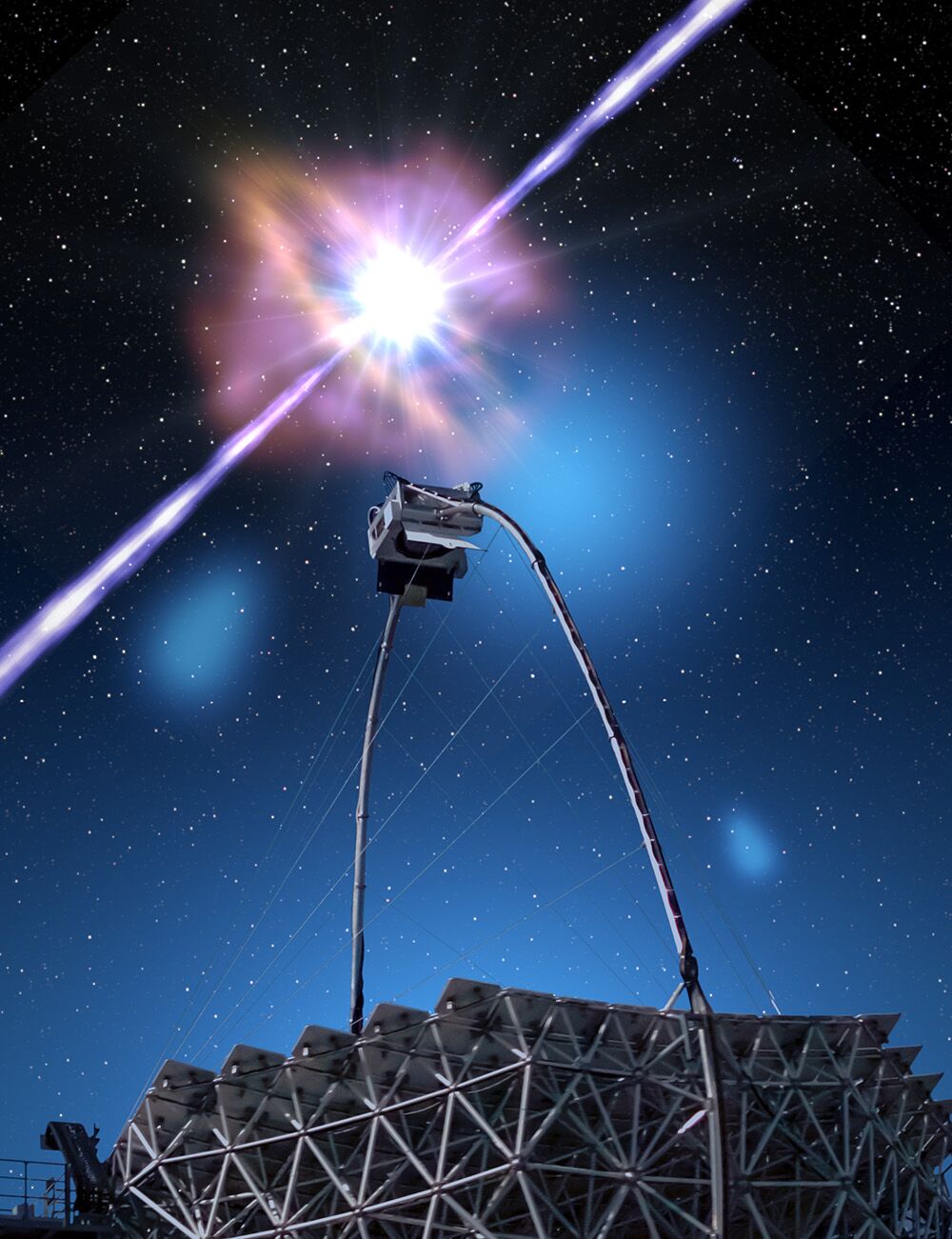
Image Credit: Gabriel Pérez Díaz, IAC
Highest energy photons from a newly revealed emission process:
Although TeV emission in GRB afterglows had been predicted in some theoretical studies, it had remained observationally elusive for a long time, despite numerous searches at TeV energies over the past decades with various instruments, including MAGIC. What physical mechanism is behind the production of the TeV photons finally detected by MAGIC? Antonio Stamerra, the Deputy Spokesperson of the MAGIC collaboration, points out: "These energies are much higher than what can be expected from synchrotron radiation, caused by high-energy electrons spiraling in magnetic fields. This process is understood to be responsible for the emission that had been previously observed at lower energies in GRB afterglows. These new results, together with the very comprehensive MWL data, provide the first unequivocal evidence for an additional, distinct emission process in the afterglow”. Lara Nava, scientist associated with the MAGIC collaboration, adds: “From our study, the most likely origin of the TeV emission is the so-called inverse Compton process, where a population of photons are significantly kicked up in energy by colliding with high energy electrons”.
“After more than 50 years since GRBs were first discovered, many of their fundamental aspects still remain mysterious”, says Razmik Mirzoyan, the Spokesperson of the MAGIC Collaboration. “The discovery of gamma-ray emission from GRB 190114C in the new, TeV window of the electromagnetic spectrum shows that the GRB explosions are even more powerful than thought before. The wealth of new data on GRB 190114C acquired by MAGIC and the extensive MWL follow-up observations now offer important clues to unravel some of the mysteries concerning the physical processes at work in GRBs”.
A comparative study of all previous GRB follow-ups by MAGIC suggests that GRB 190114C was not a particularly unique event except for its relative proximity (light took 4.5 billion years to reach the Earth), and that the successful detection owes to the excellent performance of the instrument. "MAGIC has opened a new window to study GRBs", says Susumu Inoue, the coordinator of the MAGIC Transients working group most involved in the project. "Our results indicate we may be able to detect many more GRBs at TeV energies. This will pave the way for a much deeper understanding of these fascinating cosmic explosions."
The discovery has been reported on
 Nature 575, pages459–463(2019)
Nature 575, pages459–463(2019)
 Nature 575, pages455–458(2019)
Nature 575, pages455–458(2019)
MAGIC telescopes trace origin of a rare cosmic neutrino
For the first time, astrophysicists have localized the source of a cosmic neutrino originating outside the Milky Way. It is highly likely that the neutrino comes from a blazar, an active black hole at the center of a distant galaxy in the Orion constellation. How did the scientists reach this interesting finding? They combined a neutrino signal from IceCube with measurements from the Fermi-LAT and MAGIC telescopes together with other instruments. This multi-messenger observation was also able to provide a clue to an unsolved mystery: the origin of cosmic rays.
Neutrinos are elementary particles that hardly interact with the surrounding world at all. Although difficult to detect, neutrinos are important cosmic messengers since they carry unique information about the regions where they are produced.
The largest detector specialized in hunting the shy particle species is IceCube, which is located at the South Pole. It detects about 200 neutrinos per day, although most of them have low energy and are produced by cosmic rays interacting with the Earth’s atmosphere.
Neutrino triggers multi-messenger observations:
On 22 September 2017, IceCube detected a neutrino that was special: Its very high energy (roughly 290 teraelectronvolt) indicated that the particle might have originated from a distant celestial object. Scientists were also able to identify its incoming direction with high precision.
“Theories predict that the emission of neutrinos will be accompanied by the release of light particles, also called photons”, explains Razmik Mirzoyan, MAGIC Collaboration spokesperson and scientist at the Max Planck Institute for Physics. “Photons are electromagnetic radiation and can be traced by telescopes.” Therefore, the neutrino alert was promptly disseminated to numerous instruments in the hope that their observations might disclose the source of the neutrino.
In fact, Fermi-LAT, a space observatory that conducts all-sky surveys, reported that the direction of the neutrino was in line with a known gamma-ray source in an active state: the blazar TXS 0506+056. What is more, MAGIC a 17-meter twin telescope that probes high energy gamma-rays from the ground, revealed that the radiation from the blazar reaches energies of at least 400 gigaelectronvolts.
These findings, combined with the neutrino direction, make the blazar a likely candidate for the neutrino source. TXS 0506+056 is an active galactic nucleus, the energetic core of a galaxy at a distance of 4.5 billion light years from Earth. It hosts a supermassive black hole ejecting so-called jets – outflows of particles and energetic radiation moving close to the speed of light.
A hot trail to cosmic radiation:
Since the birth of neutrinos is always linked to proton interactions, the observations help to solve an old mystery: The birthplace of cosmic radiation, discovered by the physicist Victor Hess in 1912, which is so far unknown. Cosmic rays largely consist of high-energy protons. “The cosmic neutrino tells us that the blazar is capable of accelerating protons to very high energies – and therefore may actually be one source of cosmic radiation”, explains Elisa Bernardini, scientist at DESY in Zeuthen.
There is a reason why cosmic ray sources are so hard to find. “Positively charged protons are deflected by magnetic fields in space”, Bernardini continues. “So they do not travel along straight lines, we cannot see which direction they come from.” By contrast, neutrinos and photons possess no charge, which is why they travel through the universe without detours. This means that the objects from which they originate can be reliably identified.
Born to proton parents in the jet:
However, there are still a lot of questions on the underlying processes in the blazar. “We are looking for the specific site and the mechanism able to accelerate protons, making them the parents for both high-energy neutrinos and photons”, says Mirzoyan. A follow-up study by MAGIC delivers some possible answers.
After the alert, the telescopes observed the flaring blazar for about 41 hours. The data indicate that the protons are interacting in the blazar’s jets. “What is more, the results confirm that besides the neutrino, a part of the gamma-rays are produced by high-energy protons – and not by other particle interactions in the jet. This is the very first time we can confirm that both neutrinos and gamma rays stem from proton parents”, adds Mirzoyan.
The scientists found a very distinctive fingerprint in the spectrum of high-energy gamma-rays from TXS 0506+056. “We see a loss of photons within a certain energy range, meaning these particles must have been absorbed”, says Bernardini. “This fingerprint also implies that the IceCube neutrino may be the result of interactions of protons with photons in the jets of the blazar.”
“This result corroborates a genuine connection between the different particle messengers: the neutrino and the photons”, says Mirzoyan. “Gamma radiation provides information on how the ‘power plants’ in supermassive black holes work: that is, how the extremely high energy output comes about and which particle physics processes take place.”
MAGIC observes a gravitational lens at very high energies
According to Einstein's General Relativity, light is deflected passing close to a large mass. To a distant observer the mass focuses light like a giant lens. The
result is a much brighter, although distorted, image of the source and a chance to see distant objects that might otherwise be far too faint to detect. And just like a
lens, light can pass through the lens with slightly different path lengths. On cosmic scales, this means photons -- parcels of light -- traveling along different
lines of sight arrive at slightly different times. If, in addition, the source is variable, this is "imprinted" on the light with a time delay relative to a fixed first arrival. And
this should not depend on the energy of the photons, according to the theory. That makes such observations especially important.
QSO B0218+357 harbors a supermassive black hole in a galaxy located halfway across the Universe from Earth. Over 7 billion years ago a gigantic explosion
occurred in this object, which led to the emission of an intense flare of gamma rays, which is the highest-energy form of light. In its long journey toward Earth,
these photons passed in the vicinity of a foreground — still distant — galaxy, B0218+357G, over one billion years later. In passing and being deflected, those
photons traveling along the shorter path finally arrived at Earth on July 14th, 2014 and were observed by the Large Area Telescope on board the orbiting Fermi
satellite, which scans the entire sky every 3 hours. The detection of this gammaray outburst alerted the astronomical community, and many telescopes
worldwide were immediately pointed at QSO B0218+357 to learn more from this distant cosmic explosion. Researchers operating the MAGIC telescopes, located
on La Palma in the Canary Islands, became excited about the possible observation of this object in very-high-energy gamma rays. These could provide
the most extreme perspective of this outburst, but, unfortunately, at that time there was full moon in La Palma, which prevented the operation of the MAGIC
telescopes. The MAGIC telescopes measure very-high-energy gamma rays, which are a thousand times more energetic than those measured by Fermi, and a
hundred billion times more energetic than any light we see from our Sun.
From the earlier measurements of this object in 2012 by Fermi and by radio telescopes the scientists knew that photons arriving along the longer path should
arrive about 11 days later. “In other words, Nature could award us with a replay, a second chance to look at the same interesting phenomenon.” says the MAGIC
Collaboration member Julian Sitarek (University of Łódz, Poland and IFAE former member of the Institut de Fisica d'Altes Energies in Barcelona, Spain, when he
started this project) who led this study, and continues: “When the time came, the MAGIC telescopes were pointed at QSO B0218+357, and, in accordance with
the prediction, a flare of very-high-energy gamma rays was observed, making QSO B0218+357 the most distant object detected in the very-high-energy
gamma-ray domain to date.” These very-high-energy gamma-rays from any distant source have a high chance to interact with the numerous low-energy
photons emitted by galaxies and stars, being lost in the process. With this observation, MAGIC has doubled the previously known visibility range of the
Universe in very-high-energy gamma rays. Observation of the delayed signal from QSO B0218+357 by MAGIC showed for the first time that these very
energetic photons are also deflected in agreement with General Relativity, a result that is both striking and potentially profound. The signal arriving at the
predicted time may rule out some theories of the structure of the vacuum. That awaits further analysis. For the moment, this observation demonstrates a new
capability of the very-high-energy gamma-ray observatories and highlights what awaits the next generation of such telescopes, the Cherenkov Telescope Array
(CTA) project
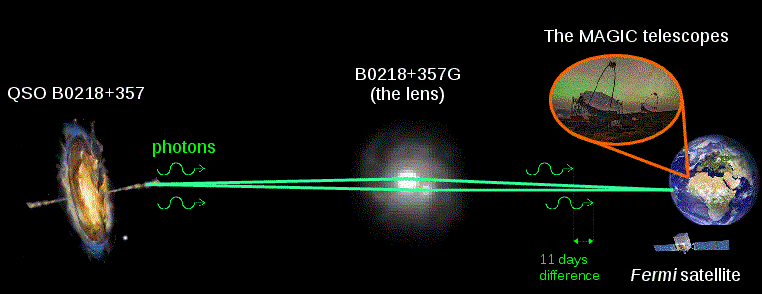
Figure 1: Photons are emitted from a galaxy QSO B0218+357 in the direction of the Earth. Due to the gravitational effect of the intervening galaxy B0218+357G photons form two paths that reach Earth with a delay of about 11 days. Photons were observed by both the Fermi-LAT instrument and the MAGIC telescopes. (MAGIC Image credits: Daniel Lopez/IAC; Hubble image of B0218+357G credits: NASA/ESA; AGN image credits: NASA E/PO - Sonoma State University, Aurore Simonnet)
The original MAGIC article can be seen
 here.
here.
A message from Crab Pulsar in TeraelectronVolt fonts
The Crab Pulsar, PSR J0534+220, is a young neutron star that was created after the supernova explosion SN1054. Its mass is about 1.5 times the mass of the Sun, concentrated in an object of about 10 km diameter. It rotates 33 times per second, and it is surrounded by a region of intense magnetic field ten thousand billion times stronger than that of the Sun. This field is strong enough to dominate the motion of charges and forces charged particles to rotate and spiral around the neutron star. This region is called the magnetosphere. The rotation of the magnetic field generates intense electric fields that literally tear charged particles from the surface. As accelerated charged particles stream outward, they produce beams of radiation that we receive every time the beam crosses our line of sight, like it happens with a lighthouse. The Crab is the most powerful pulsar in our Galaxy. It is one of the few pulsars that has been detected across the electromagnetic spectrum from radio up to gamma rays, and is one of the brightest at high energies. Its pulsar wind nebula, the Crab nebula, is also the standard candle for many experiments detecting gamma-rays, as MAGIC: in 2008 for the first time pulsed emission was discovered in the Very High Energy range (E. Aliu et al., Science, 322, 1221(2008)), revolutionizing the existing models of pulsars as the Polar Cap model.
Following that discovery, in 2011 and 2012 the energy range of the emission observed from Crab Pulsar expanded up to 400 Giga Electron Volts (GeV), and also bridge emission between
the pulsed peaks was detected: now after an extensive work collecting ~320 hours of very good quality data observing Crab, MAGIC reported in the paper published
in A&A  vol. 585, A133 (2016)
the discovery of the highest pulsed emission ever detected in our Universe, 1.5 Tera Electron Volts(TeV).
The mechanism behind such an unexpected highly energetic gamma-ray emission is not easy to be understood. The existing models fail to describe the extension of
the emitted energy up to 1.5 TeV, that could only be ascribed to an Inverse Compton process at work in the Crab pulsar, dominating the emission of gamma-rays
above 50 GeV.
vol. 585, A133 (2016)
the discovery of the highest pulsed emission ever detected in our Universe, 1.5 Tera Electron Volts(TeV).
The mechanism behind such an unexpected highly energetic gamma-ray emission is not easy to be understood. The existing models fail to describe the extension of
the emitted energy up to 1.5 TeV, that could only be ascribed to an Inverse Compton process at work in the Crab pulsar, dominating the emission of gamma-rays
above 50 GeV.
The new results probe the Crab Pulsar as the most compact TeV accelerator known to date, and require a revision of the state-of-the-art models proposed to explain how and where gamma-ray pulsed emission up to 1.5 TeV are produced. Due to the big amount of data used for this research it was also possible to perform a detailed study of how the pulsar emission (phaseogram) changes with energy. These results are key for the understanding of pulsars and will be an hard test for new theories to come.
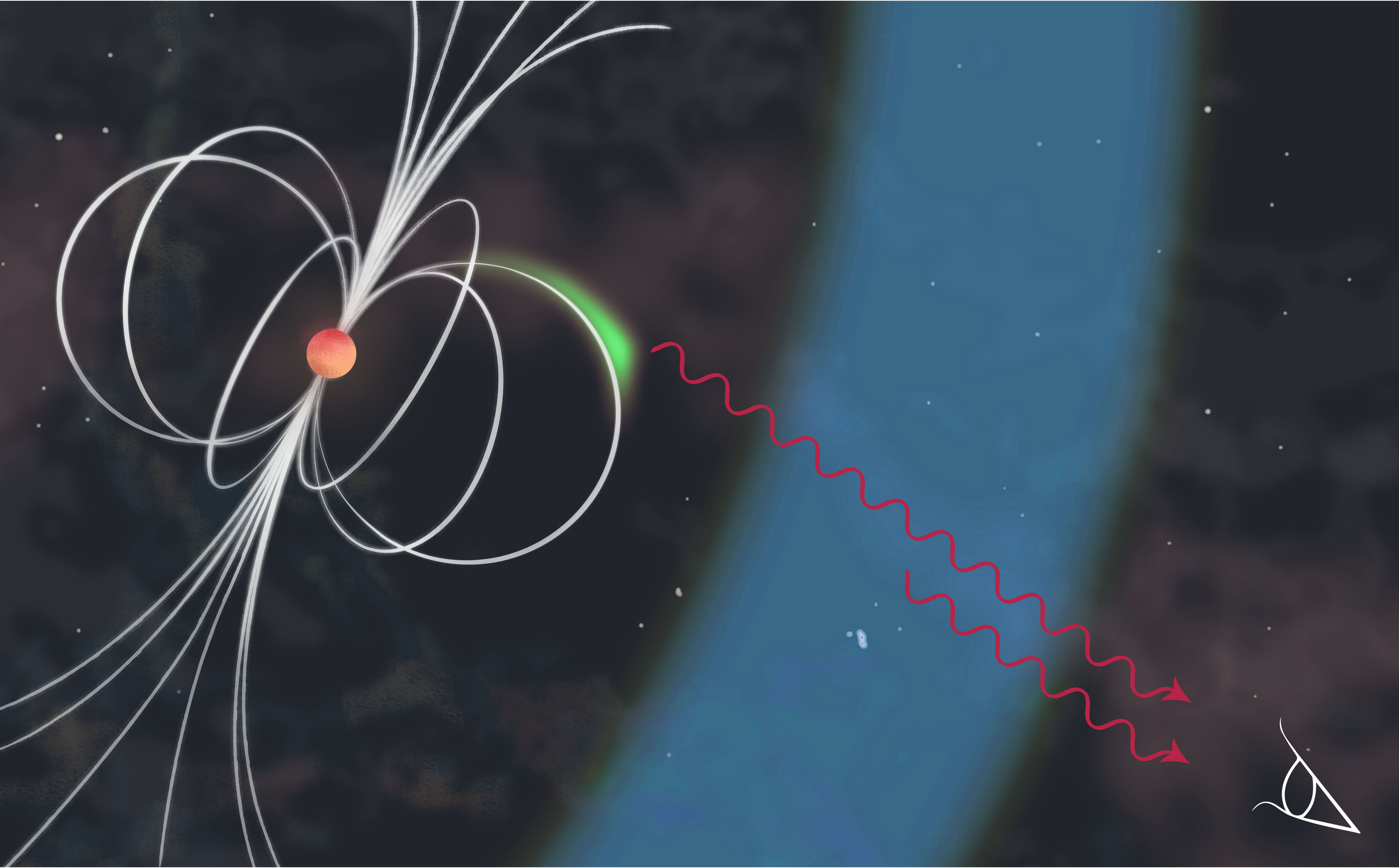
Image Credits: Patricia Carcelén Marco
Figure: The neutron star (red sphere) with its strong magnetic field (white lines) spins around itself nearly 30 times per second injecting energetic electrons in the space region around it. The green and blue shaded regions depict different particle acceleration zones from where the detected photons could originate. The green zone lies in the vicinity of the pulsar's magnetosphere, whereas the blue zone could be as far as 100.000 km away from the pulsar
Very-high-energy gamma rays from the Universe's middle age: the first detection of the distant galaxy PKS1441+25
PKS 1441+25 is one of the two most distant active galaxy detected up to such extreme energies. The very high-energy emission is attenuated on its way to Earth due to the interaction with the diffuse light filling the Universe, the extragalactic background light. This diffuse light retains the history of the stars and galaxies evolution and, hence, the story of the evolution of the Universe. PKS 1441+25 was used as a lighthouse to derive information on the evolution of the Universe from half its age up to the present day. Beside its distance, PKS 1441+25 is one of the very few Flat Spectrum Radio Quasars detected at such extreme gamma-ray energies, allowing to study its intrinsic characteristics.
On April 2015, the Large Area Telescope detected an increase of the activity of PKS 1441+25 and MAGIC followed up the alert, discovering VHE gamma rays from the object. Some of the galaxies are called active, as they produce in their central parts much more light that can be explained by the stellar and dust emission. Active galaxies, hosting at their centers a supermassive black hole with a mass of million up to few billion times the mass of the Sun are amongst the most powerful objects of the Universe and dominate the gamma-ray sky: they are able to accelerate charged particles up to very high energies. Following a classification based on their luminosity and other astrophysical important features, PKS 1441+25 belongs to the Flat Spectrum Radio Quasars family and emits very energetic gamma rays from the vicinity of its central black hole. Flat Spectrum Radio Quasars are enigmatic sources and scientists struggle to explain the emission of VHE gamma rays from them, observations such as those performed by MAGIC give crucial inside into those sources. Gamma rays depict the extreme Universe, but such highly energetic emission suffers absorption in the journey to the Earth due to the interaction with diffuse emission, the extragalactic background light. The extragalactic background light acts as a sort of ‘haze’ which dims the gamma-ray brightness of distant galaxies. This ‘haze’ was generated by stars and dust throughout the history of the Universe. It traces the evolution of the Universe after the appearance of the first stars. In this context, powerful active galaxies, such as PKS 1441+25, can be used as distant lighthouses to infer the characteristics of the extragalactic background light between the Earth and the position of the active galaxy.
The emission detected from the active galaxy PKS 1441+25 has been traveling for half of the age of the Universe. PKS1441+25 and QSO B0218+357, another source recently detected by MAGIC, are the oldest VHE gamma rays ever detected from ground observatories.
In the paper published the 15th of dec 2015 in the AstroPhysics Journal Letters,  vol. 815 L23,
the current models of the extragalactic background light which constrain the evolution of the Universe from its middle age until today were tested for the first time up to energies never reached before for such distant galaxies.
vol. 815 L23,
the current models of the extragalactic background light which constrain the evolution of the Universe from its middle age until today were tested for the first time up to energies never reached before for such distant galaxies.
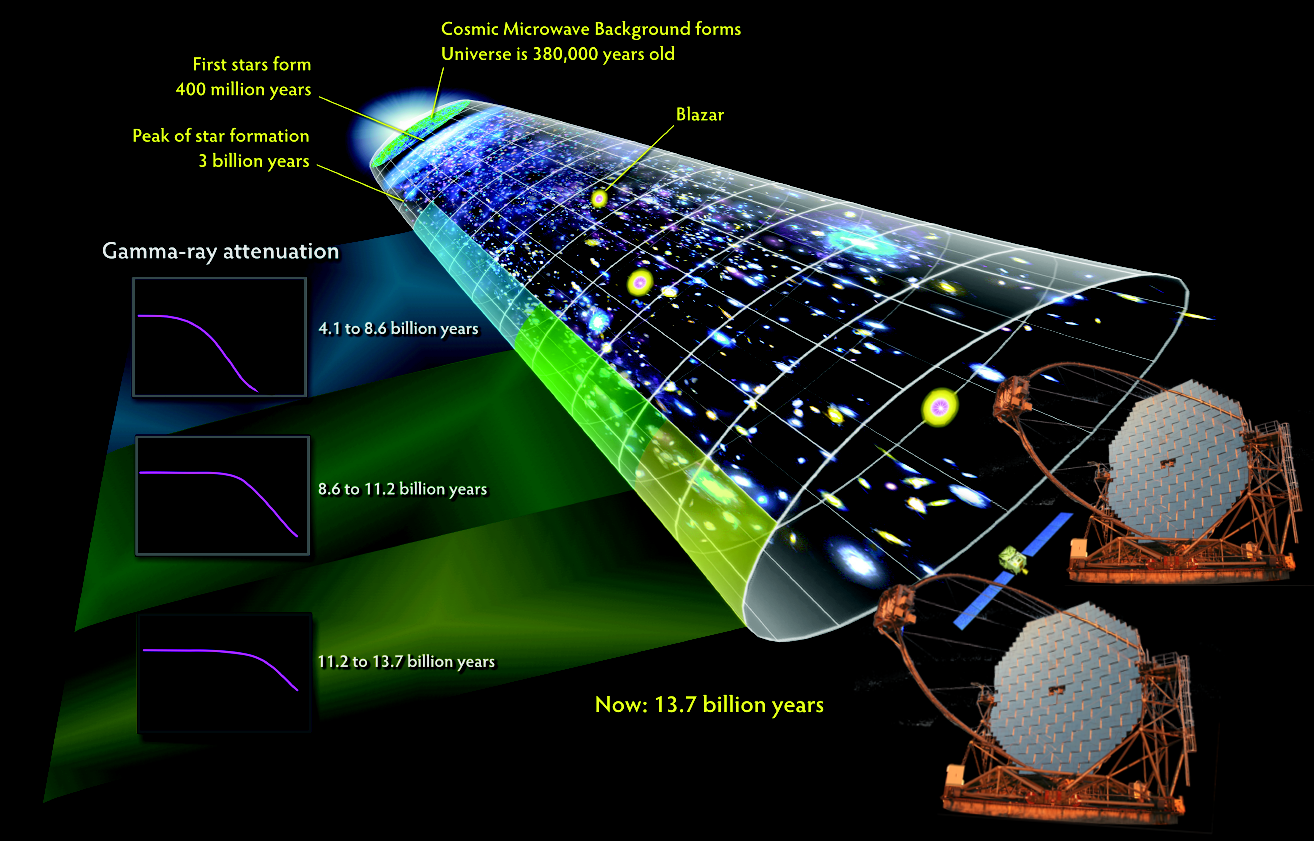
MAGIC Telescopes observe the birth of a jet close to the event horizon.
Over 250 millions years ago a powerful burst of very high energy gamma-ray radiation left the vicinity of a supermassive black hole in the nucleus of the galaxy named by astronomers as IC 310. The flickering of the gamma-ray flare on time scales of less than five minutes shows that it originated from a region smaller than the event horizon of the black hole. This finding supports the idea that such an extraordinary emission was due to particles accelerated in an extremely narrow region located near the event horizon of the black hole, and permeated by strong electric fields. Such structures are expected to form near rapidly-spinning black holes that power radio jets by their rotational energy loss.
IC 310
IC 310 is a galaxy belonging to the Perseus cluster of galaxies at a distance of about 260 million light-years from Earth. It is famous for hosting a supermassive black hole of over 300 million solar masses.
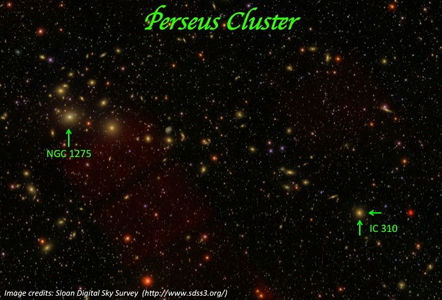
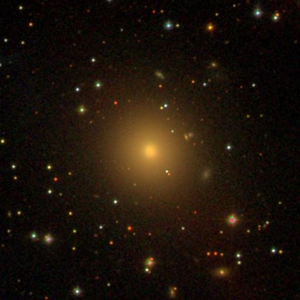
Supermassive black holes with masses ranging from a million up to
few billion times the mass of the Sun are thought to reside in the center
of all galaxies. In some fraction of these, accretion of matter onto these
objects produces unusually intense emission visible as a star-like core called
an active galactic nucleus, AGN. This accreting matter does not fall directly
into the central black hole, but circulates around it in a dense disk.
Supermassive black holes are expected to expel plasma jets at the
expense of their rotational energy. They induce currents in the
surrounding accretion flow associated with large-scale magnetic fields,
collimating and accelerating charged particles. Jets of plasma are thus
produced and ejected into the interstellar medium at tremendous velocities
approaching the speed of light. The core of an active galaxy, powered by
the central black hole and composed by the disk and the jets, is thus emitting
light across the entire electromagnetic spectrum.
IC 310 is famous for an extended radio jet emerging from its center.
For decades, the origin of this jet has been a puzzle. It emits a power that
corresponds to the radiation output from ten billion stars and emerges
from an extremely compact central part of the galaxy. Employing the
EVN network of radio antennas, high-resolution images of the jet in
IC 310 revealed a very straight structure emerging from a compact
core smaller than a light year.
Fermi/LAT and MAGIC discovered very high energy emission from this
galaxy in 2009. After these findings, IC 310 has been considered
a very peculiar source and has been carefully monitored at all wavelengths.
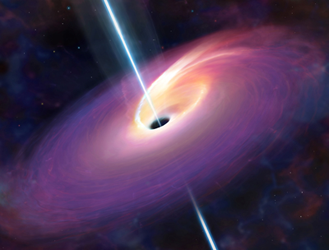
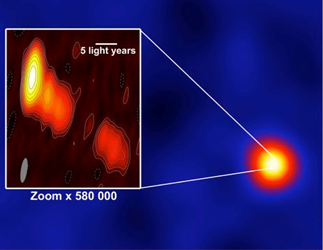
Left panel: artist view of the core on an active galactic nucleus. The supermassive black hole is at the center and, both, the accretion disk and the jet are shown. Right panel: Significance map (false color scale) of the Perseus cluster sky region in gamma rays observed in the night of November 12th, 2012, with the MAGIC telescopes. The bright source shown in the gamma ray image is IC 310. The insert shows the radio jet image of IC 310 at 5.0GHz obtained with the European VLBI Network (EVN) on October 29th, 2012.
The finding
During a further observation campaign of IC 310, in the night of
12 November 2012 a very powerful gamma ray emission, coming from
this source, was observed by MAGIC: this emission varied on time
scales of less than five minutes. Information about the structure of the
source is encoded in its variability. The shorter the variability time scale,
the smaller the size scales that can be probed. A source region must be
smaller than the distance that light can travel during the variability time
scale. Since the shortest variability time scales arise at the highest photon
energies, gamma-ray observations hold the clue to uncover the size of
the jet formation region. Moreover, the event horizon of the supermassive
black hole in IC 310 is known to be about three times as large as the
Sun-Earth distance, and finding variable gamma-ray emission at only one
fifth of this distance was a complete surprise. According to the current
picture, the observed gamma rays arise at shocks traveling down the jet.
However, the minimum time scale for the emission originating at shocks
is given by the light crossing time across the event horizon which limits
the radius of the jet from below. Now, the MAGIC observations tell a
different story. If the plasma around the supermassive black hole is
very rarified, the jets should develop regions near the rotational pole
where the density is too low for charges to shortcut the electric fields
arising due to the rotation of the magnetic field. These intensely
electrified regions resemble the vacuum gaps in pulsar magnetospheres,
which are known to accelerate particles to very high energies, exceeding
more than ten thousand times the rest mass equivalent energy of the
elementary constituents of matter, protons and neutrons, and tapping
a significant fraction of the total outflow energy.
Thus, the observations of IC 310 may be the first hint providing
direct clues on the enigmatic jet formation process near black holes.
This exceptional result obtained by using the MAGIC
and EVN telescopes is now published on the  issue of November 6th
2014 of Science Express.
issue of November 6th
2014 of Science Express.
Discovery of 3C 58 (MAGIC J0205+6451)
When a massive star has consumed almost the
totality of its nuclear fuel, it undergoes a supernova explosion and its fate depends on its mass: if it
is heavy enough, it becomes a black hole where not even the light can escape, but if its mass does not
reach this limit, the remnant is a rapidly spinning neutron star called pulsar as a leftover. Pulsar wind
nebulae (PWNe) are nebulae powered by the magnetized wind of a pulsar. 3C 58 is a young PWN powered by a
powerful pulsar (PSR J0205+6449). The source's age is very controversial, since it is spatially coincident
with a Supernova recorded by Chinese and Japanese astronomers between August 4th and 6th in 1181 AD, although
measurements do not support this hypothesis and derive several ages, usually larger than 2500 years. The
distance to the source is also uncertain, since it was always considered to be located at 3.2 kpc but recently
a new distance of 2 kpc was proposed (Kothes, R., 2013, A&A, 560, A18 ). Due to morphology similarities
(see Figure 1 from Chandra X-Ray Observatory), 3C 58 has been compared to the best studied source in the sky,
the Crab Nebula.
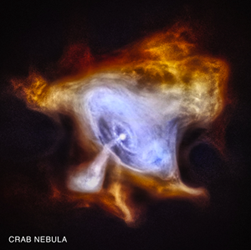

Figure 1: (left panel) Crab pulsar and Nebula and (right panel) 3C58 as seen in the X-ray (courtesy CXO). In both cases the Chandra image shows the center of the nebula, which contains a rapidly spinning neutron star surrounded by a thick ring, or torus, of X-ray emission.
Nevertheless, it was observed and undetected by
several ground-based VHE gamma-ray telescopes. 3C 58 was first detected at gamma rays by the LAT instrument
on-board Fermi satellite and the observed spectrum is extending beyond energies of 100 GeV. MAGIC finally
succeeded in discovering VHE gamma rays emitted by 3C 58 (MAGIC J0205+6451) (Figure 2) and in extending its
spectrum up to a few TeV energies (as shown in Figure 3).
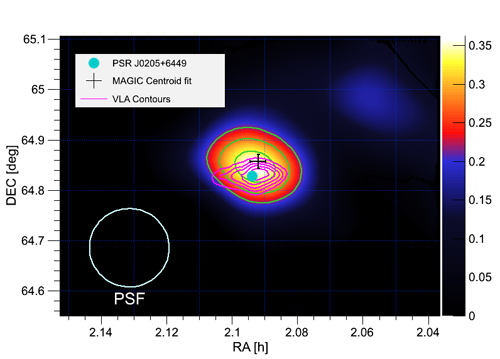
Figure 2: Skymap obtained by MAGIC. The gamma ray emission is shown together the optical position of the pulsar and the radio contours.
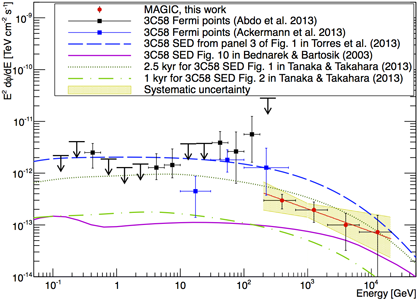
Figure 3: The Very High Energy spectrum of 3C58 including Fermi and MAGIC points and theoretical models.
MAGIC observations established that 3C 58 (MAGIC J0206+6451) is the lowest luminosity and the one with the lowest flux ever detected at VHE gamma rays as shown in Figure 4).
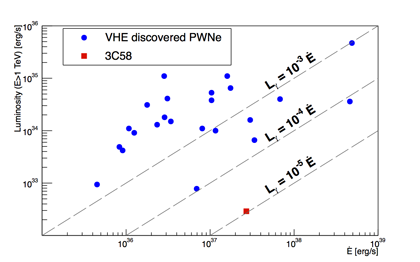
Figure 4
The assumed age that best fits the data is 2500 years, while a distance to the source of 2 kpc or a high local infrared density for a distance of 3.2 kpc might explain the multiwavelngth emission. Since the high local infrared density is unexpected, we favor the recently proposed distance of 2 kpc to the source. The magnetic field derived by the different models is very low (below 35 microGauss) and far from equipartition, which is ~ 80 microGauss.
The original MAGIC article can be seen
 here.
here.